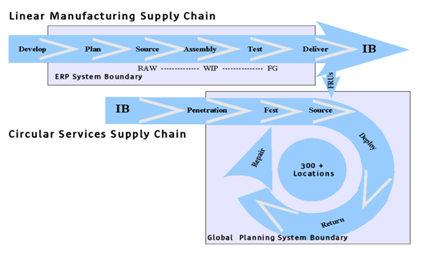If you work in Service Parts Management, you and your industry are special. No, really. Just try to run your day-to-day operations on a standard Enterprise Resource Planning (ERP) system and you’ll see why you’re the underdog of the manufacturing world.
Why Service Supply Chains Should Ditch Their ERP Solutions for Service/Aftermarket Parts Planning
If you work in Service Parts Management, you and your industry are special. No, really. Just try to run your day-to-day operations on a standard Enterprise Resource Planning (ERP) system and you’ll see why you’re the underdog of the manufacturing world. Compared to other manufacturing planning processes, service parts are unique and unpredictable.
Your plans are scrappy, flexible, and creative, and you need a platform that can handle that. This is why ERP solutions fall short for Service Parts Management professionals all over the world.
Service Parts Management Complexity
Here are some of the main nuances that differentiate Service Parts Planning and how its complexity overwhelms ERP solutions:
- Dynamic Part Chaining
- Reverse Logistics and Repair Operations
- Multifaceted Demand
- Installed Base Planning
- Service Parts Management Analytics
- Product / Part Lifecycle Management
Believe it or not, this is just the beginning of the list. Take a quick look at the diagram below.

There are major differences between Linear and Circular Supply Chains. Think about number of locations, number of part number managed, part relationships, priority in sourcing, length of time to be supported, failure rate changes over time and more. Let’s look at some of the items above in more detail.
Dynamic Part Chaining
For a great example of the resourcefulness that Service Parts Management demands, look no further than part chaining. In your world, each part can potentially go into a few different kinds of machines, as well as into older and newer models of specific machines.
Your planning system must account for this interchangeability. It should also account for part replacements and substitution options during all phases of the planning process: forecasting, target stock level recommendations, supply order recommendations (replenishments, balancing, repair, or new buys), demand fulfillment, and excess determination.
ERP applications are not designed to comprehend two-way interchangeability and one-way substitution material chaining relationships throughout the entire planning process. The lack of this core functionality forces planners to plan parts individually versus as a comprehensive chain. This in turn negatively impacts planner productivity and increases inventory investment, excess inventory, and inventory write-offs.
Reverse Logistics and Repair Operations
Not only do you use parts in different iterations of a machine, but you also use parts at different stages of their own lifecycle. Again, Service Parts Management is scrappy and resourceful.
When a high-cost spare has served a certain purpose, you can refurbish more cost effectively than purchasing a replacement. To generate an effective supply plan, your planning system should independently forecast expected defective returns, account for the scrap rate in the repair process, and balance repair orders with other sources of supply. ERP solutions lack rigorous service parts return and repair loop planning capabilities and may not understand that some parts can be upgraded to new revision levels (chaining) during the repair process.
Multifaceted Demand
Service parts networks interface with the ebb and flow of life in real time, which implies some chaos. Your demand comes from multiple sources, including unplanned failures, planned maintenance activities, remote warehouse replenishment, requirements transfer, part sales to third parties, and more.
Some of these streams may be very low volume, some may be seasonal, and some may be based on a known forward-looking schedule. To account for the flux and breadth of your demand streams, ERP solutions often force users to manage multiple forecasts on separate screens, as they lack the variety of algorithms you need.
Installed Base Planning
Your customer relations thrive on meeting Service Level Agreements (SLAs), and some of these agreements involve tight timelines (2hr, 4hr, SBD, NBD, e.g.). If you miss them, you may incur penalty fees and damage your relationships with customers. It’s critical that your inventory planning solution helps you meet customer expectations, and to do so, it must keep track of all your various SLAs and where your products live.
Installed Base Planning is an effective process which helps you place parts in the right inventory locations to meet customer demands even if failure rates are low. There is a need to understand Install Base (as Shipped and even better as Serviced), Failure Rates/MTBF’s, and map to the Products Lifecycles. When it comes to Installed Base Planning, ERPs only forecast based on history rather than proactively positioning appropriate stock before demand occurs.
Service Parts Management Analytics
As we’ve emphasized, service inventory planning is unique and textured: It makes sense that the reports to go along with it are just as specialized. Take root cause reporting, for instance. It’s an essential report that helps untangle the complexity of why inventory was not available to fill a service request. The phrase “the devil is in the details” rings true for inventory misses, as insidious minutiae can undermine your plan. So, to get to the root cause of issues, your planning system needs to understand all the unique details that define your operation. The data that is required to be stored as a historical record is significantly different than what ERP’s store.
ERP out-of-the-box reporting will mostly include generic supply chain information, not tailored to service parts, plus it does not offer root-cause analysis reporting.
Product Life Cycle Planning
A Service Parts Management solution requires multiple techniques to support the introduction of new products to the field. To avoid accumulating excess and obsolete inventory, you need a way to establish initial stocking levels for new parts even in the absence of demand history, for instance.
A few ways to achieve effective installed base forecasting for new parts is through technologies that use part chaining and substitution logic to attach a new part to the history of an interchangeable or substitutable replacement part. Another useful method is one that allows you to associate the new part with a more established part that’s similar enough to adopt the established part’s history pattern. ERP planning may support “like part” modeling, but it’s not necessarily optimized for service parts use, as there is little or no support for part supersession chaining through the forecasting and target stock level process.
End of Life (EOL) Planning
Your team needs to think ahead of your manufacturers’ timelines, too. Even after the manufacturing process for key components of the equipment you support shuts down, you’ll have to support that equipment.
This results in the need to do an end-of-life (EOL) parts requirement estimate so you can acquire the inventory to support a product for the next five years or more. ERP planning solutions focus on the unique manufacturing requirements of discontinuing a product, but not the long-term service perspective. The manufacturing life of a product is very short compared to the service life. ERP’s manufacturing-centric EOL planning does not consider the impact of install base decommissioning, repairability, and long-term forecasts.
What to Find in an Alternative
We’ve covered some of the reasons why an ERP system falls short in supporting complex Service Supply Chains. Now we’ll review what a more ideal solution looks like for your operations.
First off, it pays to find one that was built by actual Service Parts Management professionals, as they understand the unique needs of your business.
Some other standout features include:
- Demand forecasting that uses product field lifecycles and detailed as-maintained bills of materials (BOMs, not just historical demand summaries)
- Support and planner mentoring
- Planning as a Service
- Total Cost Optimization, which determines when it’s in your best interest to stock a part or not and provides alternate stocking and fulfillment strategies for immediate need.
All these capabilities will allow you to spend less time managing escalations and increase the profitability of your service revenue.
If you’re ready to learn more about which boxes to check when it comes to finding your ideal solution, learn more about Baxter Planning’s predictive Service Parts Management platform.
Lance brings over 20 years of experience in Aftermarket Service Support. He started his career at Hughes Aircraft Company as a member of their technical staff where he quickly found his passion in the area of Total Quality Management. He then worked with the Exabyte Corporation where he was responsible for the Services Repair Organization, and subsequently joined Sun Microsystems where he served as the Global Supply Chain Planning Director and ran global planning activites, led process and systems improvements in various Global Supply Chain initiatives and drove significant process efficiencies through the use of Six Sigma and other tools. Lance earned his 85 in Electrical Engineering from the University of the Pacific.




